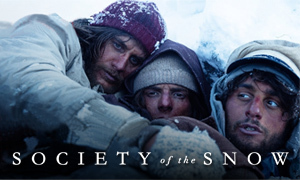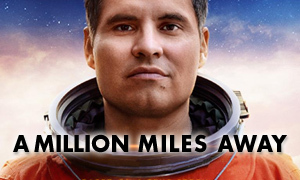Against the Ice: History vs. Hollywood
Nikolaj Coster-Waldau
Born: July 27, 1970
Birthplace:
Rudkøbing, Denmark
Ejnar Mikkelsen
Born: December 23, 1880
Birthplace: Vester-Brønderslev, Jutland, Denmark
Death: May 1, 1971, Copenhagen, Denmark
Bio: Danish Explorer
Joe Cole
Born: November 28, 1988
Birthplace:
Kingston-upon-Thames, London, England, UK
Iver Iversen
Born: August 24, 1884
Birthplace: Denmark
Death: January 17, 1968
Bio: Ship Mechanic/Explorer
Charles Dance
Born: October 10, 1946
Birthplace:
Redditch, Worcestershire, England, UK
Niels Neergaard
Born: June 27, 1854
Birthplace: Ugilt, Hjørring
Death: September 2, 1936, Copenhagen, Denmark
Bio: Council President of Denmark
What was the purpose of Ejnar Mikkelsen's expedition?
The Against the Ice true story confirms that Danish explorer Ejnar Mikkelsen (Nikolaj Coster-Waldau) and his crew, including rookie ship mechanic Iver Iversen (Joe Cole), embarked on their 1909 expedition to Greenland to recover records proving that the territory is one piece of land, not two. Confirming that Greenland is a single piece of land would disprove American explorer Robert Peary's arguably self-serving claim that a channel, nicknamed the Peary Channel (pictured below), separated part of Northeastern Greenland from the rest of the land mass, thus putting that area within American coastal waters.
The only way to disprove Peary's outline of the East Greenland coast and establish that the entire territory was part of the Kingdom of Denmark would be for the Danish government to fund expeditions to map the region.
Did members of a previous expedition to North Greenland perish when they were unable to make it back?
Yes. In researching how true is Against the Ice, it's accurate that members of Ludvig Mylius-Erichsen's ill-fated Denmark Expedition (1906-1908) buried the definitive findings from their journey in a cairn (man-made pile of stones) when they knew they would be unable to complete the return trip to their ship. It's true that the location of the cairn was discovered on a poorly drawn map found on the body of one of Mylius-Erichsen's team members, Greenlandic explorer Jørgen Brønlund, who had perished in Lamberts Land. Two other members of the expedition had died prior to Brønlund, including cartographer Niels Peter Høeg Hagen and Ludvig Mylius-Erichsen himself about ten days after Hoeg-Hagen.
Did Ejnar Mikkelsen find a map on the body of a member of a previous expedition?
Not exactly. Early in Netflix's Against the Ice, experienced Danish explorer Ejnar Mikkelsen (Nikolaj Coster-Waldau) returns from an attempt to find the members of Ludvig Mylius-Erichsen's expedition that didn't make it back. He discovers one of their bodies in Lamberts Land, which contains a diary and a hand-drawn map to the location of the cairn that contains the vital records the previous group had gathered.
In real life, it wasn't Ejnar Mikkelsen who discovered the maps on the body of Greenlander Jørgen Brønlund. Danish explorer Johan Peter Koch, second-in-command on the Denmark Expedition, discovered Jørgen Brønlund's body and the sketch maps in the spring of 1908 in Lamberts Land. The maps had been drawn by Niels Peter Høeg Hagen, who had perished prior to Brønlund.
The real Ejnar Mikkelsen did later come across Brønlund's body, and he and his men gave it a proper burial. Part of Mikkelsen's mission was to also recover the bodies of Ludvig Mylius-Erichsen, the leader of the ill-fated Denmark Expedition, and cartographer Niels Peter Høeg Hagen. However, their bodies were never discovered and likely drifted out to sea when the ice thawed. It's true that Mikkelsen used the maps during his expedition with Iver Iversen to locate the cairn.
Is the movie's opening scene where Ejnar Mikkelsen clips off a lieutenant's frostbitten toes based on the true story?
Yes. In the movie's opening scene, Captain Ejnar Mikkelsen arrives at his ship and is carrying First Lieutenant Christian A. Jørgensen over his shoulder after the lieutenant was unable to walk due to frostbite. Jørgensen was one of the men who had gone with him in search of the three bodies from the ill-fated Denmark Expedition. Mikkelsen then proceeds to have the other men hold down the lieutenant while he uses pliers to clip off several of his blackened toes.
In his book Two Against the Ice, Mikkelsen does describe discovering Jørgensen's badly frostbitten feet in their tent, stating that "all the toes and the beginning of the foot were swollen and of the yellow, waxen color of a corpse." Jørgensen believed it must have been from when he walked through a fissure filled with water shortly after they had set out in the morning.
When they took off the bandages a week later, they saw his blue-colored toes, a sign of frostbite. They had to amputate five of his toes without a doctor, using half a bottle of whisky as their anesthetic. Jørgensen's injury resulted in him not being able to go on the long sled journeys to look for the cairn, which is part of the reason Mikkelsen took the ship's mechanic, Iver Iversen, instead.
Is Against the Ice based on Ejnar Mikkelsen's book?
Yes. The Netflix movie is based on Captain Ejnar Mikkelsen's own account of his polar expedition to North Greenland, which he wrote about in his book, originally titled Two Against the Ice: A Classic Arctic Survival Story and a Remarkable Account of Companionship in the Face of Adversity.
Did young ship mechanic Iver Iversen join the expedition after the former mechanic turned out to be a useless drunk?
Yes. The Against the Ice true story reveals that this is taken straight from Ejnar Mikkelsen's book. The Alabama Expedition's original mechanic ended up being worthless and an alcoholic. It was then that the young mechanic, Iver Iversen, joined Ejnar Mikkelsen's expedition to Greenland aboard the wooden ship Alabama.
Is it true that the real Iver Iversen had no polar experience?
Yes. In fact, director Peter Flinth chose actor Joe Cole to portray the inexperienced crew member Iversen because Cole himself had never been to Greenland or Iceland (the movie's main filming location) and was unfamiliar with the terrain and climate.
Would the crew have been speaking British English?
No. In the movie, half the Scandinavian crew speak like working-class Brits. In real life, they would have been speaking Danish since the crew, including Captain Ejnar Mikkelsen and engineer Iver Iversen, were from Denmark. The characters also use contemporary language that does not fit the time period. Contrast this with 2019's linguistically accurate The Lighthouse; another, albeit fictional, story of two men living remotely and struggling to stay sane.
Did the ship's mechanic, Iver Iversen, volunteer to go with explorer Ejnar Mikkelsen deep into the uncharted interior of Greenland?
Yes. An Against the Ice fact-check confirms that the real Iver Iversen was the only crew member to volunteer to embark on the treacherous journey with Mikkelsen across hundreds of miles of ice, rivers, and unforgiving terrain. The rest of the crew better understood the dangers of such a journey.
Is Charles Dance's character, Denmark government minister Neergaard, based on a real person?
Yes. In exploring how true is Against the Ice, we discovered that Charles Dance's character is based on Niels Neergaard, who served as the Council President of Denmark between 1908 and 1909. The title of Council Presidium is the predecessor to the modern Prime Minister's Office, which was established in 1914.
Dance's character also seems to be a composite of some of the other officials who supported Ejnar Mikkelsen's efforts in real life, including those on the Committee of the Denmark Expedition, as well as government officials in Parliament. In the movie, Neergaard stresses the importance of recovering the records from the ill-fated Denmark Expedition and supports Mikkelsen's efforts to do so.
Was Against the Ice filmed in Greenland?
While the movie was shot in both Iceland and Greenland, exploring Against the Ice's historical accuracy reveals it was mainly filmed in the more-forgiving Iceland. Director Peter Flinth avoided using green screens whenever possible so that the actual landscape could be featured. This didn't come without its challenges. During an interview with Deadline, Nikolaj Coster-Waldau said that the 50-60 person crew ended up stranded on a glacier in Iceland during a snowstorm and had to huddle together in a hut as hurricane-force winds swept across the landscape. Coster-Waldau also recalled losing control of a sled and its dogs while shooting a scene that required him to navigate the sled over some rocks. The sled and dogs ended up careening towards the crew.
Coster-Waldau said that despite wishing he could have slept out in the elements while filming in Iceland, the actors and crew stayed in hotels.
Were Ejnar Mikkelsen and Iver Iversen attacked by a polar bear?
Yes. In Ejnar Mikkelsen's book, he tells the story of a polar bear trying to break down the door of their hut as Iver tries to hold it shut. Ejnar, whose rifle was frozen, grabbed an axe until Iver could get to his rifle, which was still working. When the polar bear finally smashed the door in, Iver was able to shoot the bear in the chest and it fell to the ground and died. While the real-life situation was dire and intense, Against the Ice's polar bear standing over Ejnar and stepping on him is fictional.
Ejnar writes of several less-intense encounters with lone polar bears, which were often drawn in both day and night by the "heavenly smells" emanating from their camp. The sled dogs would fight the polar bears, and the men would shoot the bears to protect their supplies. He writes of trying to kill polar bears for food and watching them flee and float away in the seawater, injured and dying, just out of their reach. Other times, they were able to retrieve the bears and the meat provided them with nourishment for days.
In real life, one of Ejnar Mikkelsen's diaries that they had buried in a cairn had been eaten by a bear. Fortunately, Iver's diaries covered that same period, so it was not a significant loss. Many of the other perilous situations the characters encounter in the Netflix Against the Ice movie were taken from real life as well, including the relentless snowstorms, bitter cold, plunges into icy water, treacherous sledding conditions, deadly crevasses, frostbite, scurvy, and starvation.
Are they fighting a real polar bear in Against the Ice?
No. While the movie was shot on location in Iceland with limited use of green screens, the polar bear that attacks them is computer-generated, which is unfortunately somewhat obvious.
Did all of Ejnar Mikkelsen's sled dogs die on the expedition?
Yes. All of the sled dogs they took perished on the expedition. As in the movie, the Against the Ice true story corroborates that eventually, the surviving starving huskies would sometimes feed on their emaciated friends. Desperate for food, Ejnar and Iver once ate a dog as well. It wasn't uncommon for starving polar explorers to do this in order to survive.
Did Ejnar Mikkelsen and Iver Iversen return from their expedition to find that the crew had left?
Yes. Their wooden ship, the Alabama, had become trapped and crushed in the ice at Shannon Island, East Greenland. While Mikkelsen and Iversen were off exploring, the rest of the crew boarded a whaler and returned home. Before doing so, they used some of the ship's planking and timbers to construct a small hut, nicknamed the Alabama Cottage (pictured below), stocking it with enough provisions to last a year. Mikkelsen and Iversen would spend two punishing winters in the hut before they were rescued by a Norwegian whaler in the summer of 1912. The hut still exists today and has been restored in recent years.
Is Ejnar Mikkelsen's fiancée Naja based on a real person?
In the movie, while he is stranded with Iver (Joe Cole) and struggling to survive, Ejnar (Nikolaj Coster-Waldau) has hallucinations about his fiancée back home, Naja (Heida Reed). During our investigation into the Against the Ice fact vs. fiction, we discovered that there's no mention of Naja in Ejnar Mikkelsen's book, nor does he mention having a sweetheart back home at the time.
He only briefly touches on the topic of women. One instance in the book comes when he writes about the many conversations he had with Iver, one of them being how strange it would be if a woman suddenly dropped down beside them after not having seen the opposite sex in a couple of years. As Ejnar's imagination "began to run riot," Iver snapped him out of it by reminding him of how awful they looked and how they "could not captivate even the most unfastidious woman."
Ejnar also writes about how he and Iver found a postcard with a picture of a group of young ladies in front of a building. The two men then picked out imaginary girlfriends from the group. Ejnar picked one and Iver picked four (he was young). The ladies become very real in their minds. They even had a temporary falling-out when Iver wrote a love song about the woman that Ejnar had picked out. Ejnar became angry and jealous. After nearly two days of silence, Iver apologized and they agreed to forget about their fictitious relationships.
Did Ejnar Mikkelsen recover the findings from Ludvig Mylius-Erichsen's ill-fated expedition?
Yes. Captain Ejnar Mikkelsen and engineer Iver Iversen conducted several hazardous sled journeys and succeeded in recovering the records from the earlier 1906-1908 Denmark Expedition. In researching Against the Ice's historical accuracy, we discovered that, like in the movie, Ludvig Mylius-Erichsen's team's records disproved the existence of a channel (dubbed the Peary Channel) that turned part of Northeastern Greenland into an island that was within U.S. coastal waters.
Did Ejnar Mikkelsen fall ill with scurvy?
Yes. Due to an inability to find proper nourishment, Ejnar's body became deficient in vitamin C and he fell deeply ill with scurvy for several weeks. In the beginning, he had loose teeth, bleeding gums, swollen joints, vivid patches on his legs and thighs, and his strength began to wane. Researching the true story confirms that they had no medicines to treat the disease, a sickness that had plagued early polar explorers. Like so many of those men, there was a good probability that Ejnar was going to die. Iver could not make it back to the ship by himself, so it meant that he would perish as well.
For three weeks, Ejnar was so weak he was unable to walk, he fainted often, and he would slip into a semi-coma state. They continued their journey back to the ship, with Ejnar lying in the sled and Iver trying to take the least bumpy course. Miraculously, with the help of food caches that had been left several years earlier for the Denmark Expedition, Ejnar began to slowly regain his strength and was eventually able to stand again. As his strength increased, he was able to help more and more, and they eventually made it to a place where they could camp for the summer and Ejnar could recover fully.
Did Ejnar build another cairn to hide the documents in case he and Iver didn't make it back?
In the Netflix Against the Ice movie, Ejnar (Nikolaj Coster-Waldau) decides to build another cairn to store the vital documents in case he and Iver (Joe Cole) don't survive. This is based almost directly on the account in Ejnar's book. He later has a nightmare that a polar bear destroyed the cairn and he insists they make the 400-mile round trip in the spring to retrieve the diaries and documents. Sure enough, they discovered a polar bear had eaten one of Ejnar's diaries. While they are on their journey, they miss a search party that comes to look for them.
How long were the real Ejnar Mikkelsen and Iver Iversen in Greenland?
While the film hurries the action along to the next key moment on Mikkelsen and Iversen's Greenland expedition, in real life, they spent nearly three years in Greenland from 1909-1912, far too much time to be thoroughly covered in a two-hour movie.
I heard that actor Nikolaj Coster-Waldau co-wrote the script. Is that true?
Yes. Danish actor Nikolaj Coster-Waldau (Game of Thrones), who portrays Ejnar Mikkelsen in the movie, co-wrote the Against the Ice script with Joe Derrick. They adapted it from Ejnar Mikkelsen's book Two Against the Ice.
Did Danish explorer Ejnar Mikkelsen ever return to Greenland after his 1909-1912 expedition?
Yes. Mikkelsen returned to East Greenland at least two more times. He headed a 1924 expedition to settle an area that became known as Scoresbysund. In 1932, he led an expedition to the Skaergaard intrusion near the shores of the Kangerlussuaq Fjord so that the first archeological excavations of the intrusion (a large body of layered igneous rock) could be carried out.







